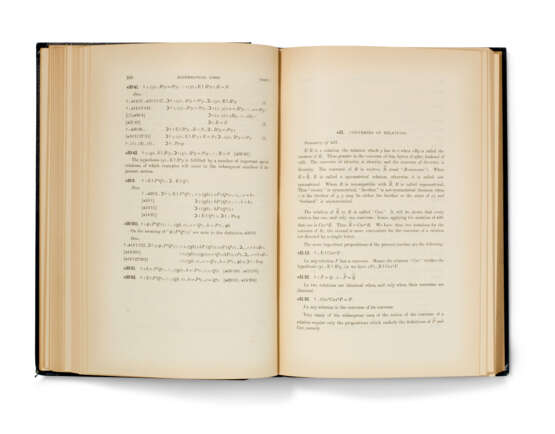ID 381360
Lot 152 | Alfred North Whitehead (1861-1947) and Bertrand Russell (1872-1970)
Valeur estimée
£ 60 000 – 80 000
First edition of all three volumes of this momentous landmark of modern thought, exceptionally rare as a complete set and not ex-library. Principia mathematica is considered the greatest single contribution to logic to appear since Aristotle. Whitehead and Russell set out to show how ‘mathematics could be derived solely from logical concepts and by logical methods … [Principia] has had an influence, direct and indirect, of near Newtonian proportions upon the spheres of its chief influence: mathematical logic, set theory, the foundations of mathematics, linguistic analysis and analytical philosophy’ (Grattan-Guinness).
After publishing the first part of his Treatise on Universal Algebra in 1898, Whitehead began preparing a second volume, a comparative study of algebras as symbolic structures. In 1900 he and his most brilliant pupil, Bertrand Russell, travelled to Paris, where they were inspired by Peano’s newly-devised ideography for symbolic logic, and saw in it the most apt tool for a reduction of mathematics to its core in philosophical logic. After Russell published his Principles of Mathematics (1903), he planned to give a completely symbolic account of the assimilation of mathematics to logic in a second volume. When the two logicians realized that their projects perfectly coincided, they began a collaboration which resulted in the publication of Principia.
‘Not only did Principia introduce a wide range of philosophically rich notions (including propositional function, logical construction, and type theory), it also set the stage for the discovery of crucial metatheoretic results (including those of Kurt Gödel, Alonzo Church, Alan Turing and others). Just as importantly, it initiated a tradition of common technical work in fields as diverse as philosophy, mathematics, linguistics, economics and computer science’ (Stanford Encyclopedia of Philosophy). ‘Whether they know it or not, all modern logicians are the heirs of Whitehead and Russell’ (Palgrave Centenary Companion to Principia Mathematica, 2013, p.20). Landmark Writings in Western Mathematics 16; Norman 1868; Blackwell & Ruja A9.1a; Church, Bibliography of Symbolic Logic, 194.1-1; Grattan-Guinness, ‘The Royal Society’s financial support of the publication of Whitehead and Russell’s Principia Mathematica,’ Notes and Records of the Royal Society of London, Vol. 30 (1975), pp. 89-104.
Three volumes, large octavo (260 x 175mm). (A few ink notes and underlining, and slight crease to four upper corners in vol. I, small marginal stain in upper comer of vol. III pp.463-469, else clean.) Original blue cloth, spines lettered in gilt, sides panelled in blind (corners of lightly bumped, hinges cracked but holding firm, small abrasion and minuscule tear to spine of vol. II, small skilful repair to head of spine in vol. III, with foot a little frayed). Provenance: J C Brown (inscription on front pastedown to vol. III) – evidence of old bookplate on front free endpaper in vol. II.
| Adresse de l'enchère |
CHRISTIE'S 8 King Street, St. James's SW1Y 6QT London Royaume-Uni | |
|---|---|---|
| Aperçu |
| |
| Téléphone | +44 (0)20 7839 9060 | |
| Commission | see on Website | |
| Conditions d'utilisation | Conditions d'utilisation |






